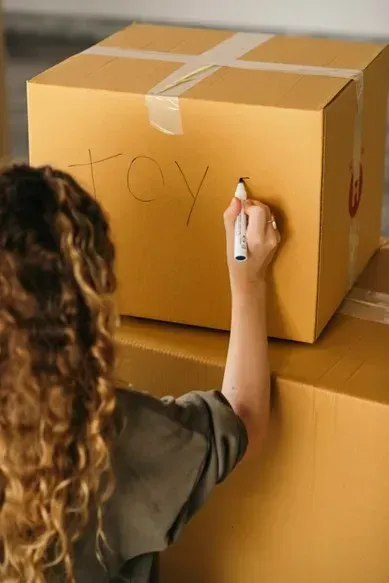NEED HELP?
CLAIM YOUR FREE QUOTE
We will get back to you as soon as possible.
Please try again later.
The Ultimate Guide to a Stress-Free Move
CLAIM YOUR FREE QUOTE
The Benefits of Hiring a Veteran-Owned Small Business

Moving to a new home can be an exciting yet overwhelming experience. Whether you're relocating across the country or just a few blocks away, the process of packing up your life and settling into a new space can be daunting. That's where a professional moving company comes in. With their expertise and resources, they can make your move seamless and stress-free. In this comprehensive guide, we'll walk you through the steps of preparing for a household move, from finding the best moving company to ensuring a smooth transition into your new home.
Table of Contents
1. The Importance of Choosing the Right Moving Company
2. Researching and Selecting the Best Moving Company
3. Gathering Moving Estimates and Budgeting
4. Preparing Your Current Home for the Move
5. Packing and Organizing Your Belongings
6. Managing Valuables and Fragile Items
7. Making Moving Day Plans and Logistics
8. Arriving at Your New Home: Unpacking and Settling In
9. Post-Move Tips and Considerations
10. The Benefits of Hiring a Veteran-Owned Moving Company
1. The Importance of Choosing the Right Moving Company
When it comes to a household move, finding the right moving company is crucial. A reputable and reliable moving company can alleviate the stress and physical strain of the moving process, ensuring that your belongings are handled with care and delivered safely to your new home. They have the experience, expertise, and resources to make your move efficient and hassle-free.
2. Researching and Selecting the Best Moving Company
To find the best moving company for your needs, it's essential to do thorough research. Start by asking for recommendations from friends, family, or real estate agents who have had positive experiences with moving companies in the past. You can also check online directories and review websites to gather a list of potential candidates.
Once you have a list of potential moving companies, it's time to dig deeper and gather more information. Consider the following factors during your research:
Licensing and Insurance
Ensure that the moving company you choose is licensed and insured. This will protect you in case of any unexpected accidents or damages during the moving process.
Experience and Expertise
Look for a moving company with a proven track record and extensive experience in the industry. A company that has been in business for several years is likely to have the necessary knowledge and skills to handle your move efficiently.
Services Offered
Consider the specific services offered by each moving company. Some companies may specialize in long-distance moves, while others may focus on local moves. Determine your needs and find a company that can cater to them.
Reviews and Testimonials
Read online reviews and testimonials from previous customers to get an idea of the company's reputation. Positive reviews and feedback are good indicators of a reliable moving company.
Price and Affordability
While price shouldn't be the sole determining factor, it's important to consider your budget when selecting a moving company. Obtain quotes from multiple companies and compare their prices to find the best value for your money.
3. Gathering Moving Estimates and Budgeting
Before finalizing your decision, it's crucial to gather moving estimates from the moving companies you're considering. This will help you budget for your move and ensure that you're getting a fair price. Contact each company and provide them with detailed information about your move, including the size of your home, the distance of the move, and any additional services you may require.
Once you receive the estimates, carefully review them and compare the prices and services offered. Be wary of any unusually low estimates, as they may be an indication of subpar service or hidden fees. Choose a moving company that provides a reasonable estimate and aligns with your budget.
4. Preparing Your Current Home for the Move
To ensure a smooth moving process, it's important to prepare your current home before the moving day arrives. Here are some essential steps to follow:
Declutter and Organize
Before packing, declutter your belongings and get rid of items you no longer need or want. This will not only reduce the amount of stuff you have to move but also make unpacking easier in your new home.
Create a Packing Timeline
Develop a packing timeline to stay organized and avoid last-minute stress. Start packing non-essential items well in advance and save essential items for the days leading up to the move.
Gather Packing Supplies
Stock up on packing supplies such as sturdy boxes, packing tape, bubble wrap, and packing paper. You can purchase these items from a moving company or collect them from local stores or friends.
Label and Inventory
As you pack, label each box with its contents and the room it belongs to. This will make unpacking a breeze and help the movers place boxes in the correct rooms in your new home. Additionally, create an inventory list to keep track of all your belongings throughout the move.
Notify Important Parties
Inform your utility providers, post office, and any other relevant parties about your upcoming move. Arrange for the transfer or cancellation of services and update your address accordingly.
5. Packing and Organizing Your Belongings
Packing your belongings efficiently is key to a successful move. Here are some tips to help you pack and organize your belongings:
Start Early and Pack Room by Room
Begin packing well in advance to avoid last-minute rush. Approach the packing process room by room, focusing on one area at a time. This will help you stay organized and prevent items from getting mixed up.
Use Proper Packing Techniques
When packing fragile items, wrap them individually in bubble wrap or packing paper. Place heavier items at the bottom of boxes and lighter items on top to prevent breakage. Fill any gaps with packing paper or clothing to ensure that items don't shift during transit.
Label Boxes Clearly
Label each box with the contents and the room it belongs to. This will help you and the movers know where to place each box in your new home. Consider color-coding the boxes for easy identification.
Pack an Essentials Box
Pack a separate box with essential items that you'll need immediately upon arrival at your new home. This box should contain toiletries, a change of clothes, important documents, and any other necessities.
6. Managing Valuables and Fragile Items
When it comes to valuable and fragile items, extra care is needed during the move. Here's how to ensure their safety:
Inform the Moving Company
Inform the moving company about any valuable or fragile items that require special handling. They can provide guidance on how to pack and transport these items safely.
Consider Insurance
If you have valuable possessions, consider purchasing additional insurance coverage to protect them during the move. Consult your moving company or insurance provider for more information.
Pack Fragile Items Carefully
Wrap fragile items individually in bubble wrap or packing paper, and place them in sturdy boxes. Use packing peanuts or crumpled paper to provide cushioning and prevent movement.
Transport Valuables Personally
If possible, transport valuable and sentimental items personally, rather than relying on the moving company. This will give you peace of mind knowing that these items are always within your control.
7. Making Moving Day Plans and Logistics
Moving day can be hectic, so it's important to have a plan in place. Consider the following tips to ensure a smooth moving day:
Communicate with the Moving Company
Stay in regular communication with the moving company to confirm logistics, such as the arrival time of the moving crew and any special instructions or requirements.
Prepare Your Home for the Movers
Clear pathways and ensure that both your current and new homes have easy access for the movers. If necessary, reserve parking spaces for the moving truck and arrange for any necessary permits.
Keep Important Documents Handy
Keep important documents related to the move, such as your moving contract, inventory list, and contact information, easily accessible. This will help you stay organized and address any concerns that may arise.
Stay Hydrated and Take Breaks
Moving can be physically demanding, so it's important to stay hydrated and take breaks when needed. Pace yourself throughout the day to avoid exhaustion.
8. Arriving at Your New Home: Unpacking and Settling In
Once you've arrived at your new home, it's time to unpack and settle in. Here are some tips to make the process smoother:
Start with Essentials
Unpack the essentials box first, ensuring that you have everything you need for the first few days in your new home. Set up basic utilities, such as electricity and water, before tackling other unpacking tasks.
Unpack Room by Room
Similar to the packing process, unpack room by room. This will help you stay organized and prevent items from getting misplaced or mixed up.
Prioritize Unpacking
Focus on unpacking essential rooms, such as the kitchen, bathroom, and bedrooms, before moving on to less crucial spaces. This will ensure that you can function comfortably in your new home from day one.
Dispose of Packing Materials
As you unpack, dispose of packing materials responsibly. Recycle cardboard boxes, reuse packing paper if possible, and properly dispose of any plastic or other non-recyclable materials.
9. Post-Move Tips and Considerations
After the move, there are a few extra steps to take to ensure a smooth transition:
Update Your Address
Notify relevant parties of your new address, including banks, insurance providers, and government agencies. Update your driver's license and voter registration as well.
Explore Your New Neighborhood
Take the time to explore your new neighborhood and familiarize yourself with nearby amenities. Locate grocery stores, healthcare facilities, schools, and other services you may need.
Connect Utilities and Services
Contact utility providers to set up services at your new home. Schedule installations or transfers for internet, cable, phone, and any other essential utilities.
Check for Damages
Inspect your belongings for any damages that may have occurred during the move. Report any issues to the moving company promptly to resolve them
.
10. The Benefits of Hiring a Veteran-Owned Moving Company
When choosing a moving company, consider the benefits of hiring a veteran-owned business like Yellow Truck Moving. This veteran-owned company brings a unique level of professionalism, punctuality, and care to your move. With their experience and dedication, they can meet all of your moving needs, ensuring a smooth and successful transition to your new home.
In conclusion, a household move doesn't have to be a stressful experience. By choosing the right moving company, preparing in advance, and following the tips outlined in this guide, you can make your move as seamless as possible. Remember to prioritize organization, communication, and self-care throughout the process. With careful planning and the assistance of a reliable moving company, you can embark on your new journey with confidence and ease.
Disclaimer: The information provided in this article is for general informational purposes only. It is not intended to be a substitute for professional advice. Veteran-owned Yellow Truck Moving is not affiliated with this article. Please consult with a professional for personalized advice tailored to your specific situation.

Lisle, Illinois 60532, United States
Yellow Truck Moving LLC,
ILCC 230260 MC
All Rights Reserved | Yellow Truck Moving

